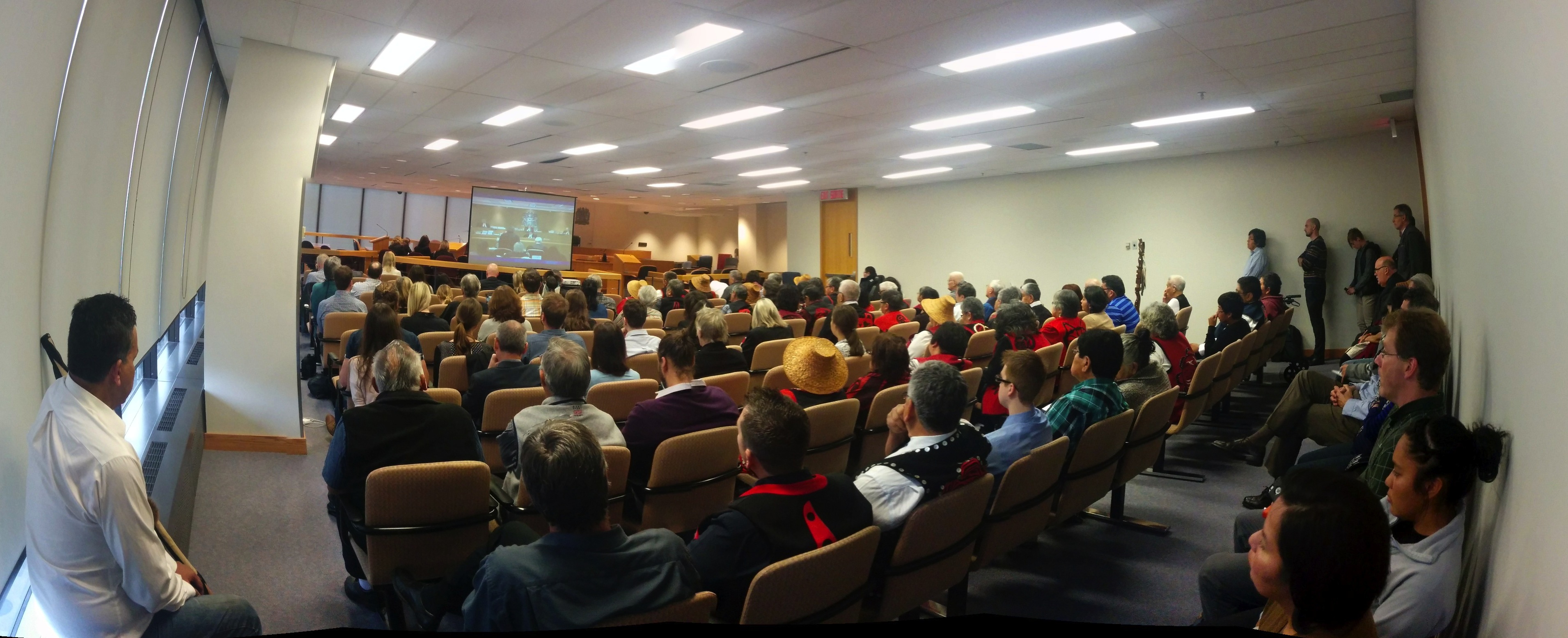
Representatives from the Haisla, Haida, Kitasoo Xai’xais, Heiltsuk, Nadleh Whut’en, Nak’azdli, Gitga’at and Gitxaala Nations travelled hundreds of kilometers to attend proceedings in front of the Federal Court of Appeal from October 1st – October 8th. These eight First Nations are challenging the federal government’s approval of the Enbridge pipeline and oil tanker project on the grounds that the federal government violated First Nations rights. The First Nations applicants are joined by four environmental organizations and a labour union presenting their arguments next week.
During the lunch break, hundreds gathered outside the court to show their support for the First Nations applicants and express opposition to the Enbridge project. Supporters drummed, sang, chanted, and carried signs, while leaders delivered speeches. Woven throughout the speeches and chants was one unifying call to action. That we must stand together. East and West. Indigenous and non-Indigenous. In the courts, on the streets, on the land, and on the water. We must stand together to protect the land for future generations.

The courtyard was packed with over 500 people gathered for a solidarity rally. (Photo by Georgia Lloyd-Smith)
The Legal Proceedings
The courtroom was packed tight today and the air was charged. Chiefs, community members, lawyers and media sat side-by-side to watch the proceedings unfold, filling out every corner of the 100 person capacity room. Three lawyers were each given 85 minutes to make their case in front of the panel of three Federal Court of Appeal judges. The legal arguments centered on the Crown’s failure to consult with First Nations before approving the Enbridge pipeline project (see WCEL Legal Backgrounder for a high-level summary of the legal arguments). All three lawyers delivered eloquent submissions with concise arguments and clear responses to the Panel’s questions.
First up was Jennifer Griffith, counsel for the Haisla Nation. Griffith argued that the Haisla Nation was never meaningfully consulted on the impacts of this project on their Aboriginal rights and title. She raised the concern that construction of the marine terminal would destroy culturally modified trees - trees that have been used and left standing as living legacies in Haisla culture. She noted that denying the possibility of accommodating First Nations concerns from the outset is not meaningful consultation, that the Crown consultation process cannot merely be a way to “blow off steam”, and that the Haisla should not be forced to rely upon a “specter of future consultation”. In particular, she noted that the Haisla have a strong claim of Aboriginal title to the terminal site that stands to be seriously impacted by the Enbridge terminal, which would prevent the Haisla from managing, using and benefiting from those lands, and that the Crown cannot postpone consultation about those impacts to some later process.

The chiefs of all eight nations in court hold a press conference before the hearings kick off. (Photo by Georgia Lloyd-Smith)
Terri-Lynn Williams-Davidson - whose Haida name is Gid7ahl-Gudsllaay - counsel for the Council of Haida Nation, focused on the distinctiveness of Haida’s legal position. Williams-Davidson argued that Canada was wrong to use a generic, one-size-fits-all consultation process for the unique First Nations involved. She noted, “We each have our own legal box of treasures.” The crux of the Haida case was the Crown’s obligation to honour existing government-to-government agreements between the Haida and the Crown, agreements reached in the spirit of reconciliation which set out particular consensus-seeking and dispute resolution processes for making decisions that affect the relevant waters and lands in Haida territory. These distinct Haida agreements created a unique relationship between the Haida and the Crown and a heightened duty to consult with the Haida that was not met because the Crown maintained these agreements did not apply in the case of decision-making about Northern Gateway. She ended by noting that the court has a duty to learn about Indigenous legal traditions and urged the Panel to find space for the Haida legal order.
Finally, Lisa Fong, representing the Kitasoo Xai’xais and Heiltsuk Nations, emphasized a number of information gaps that were created because the Crown failed to ensure that important information about the nature of oil spill impacts in Heiltsuk and Kitasoo Xai’xais waters was produced. She argued that without such information there could not be meaningful consultation on the impacts to Kitasoo Xai’xais and Heiltsuk Nations’ Aboriginal rights. She also argued that the approval of the Project infringes the Heiltsuk Nation’s established right to harvest and sell herring spawn, which was recognized by the Supreme Court of Canada (see R v. Gladstone). Fong made the point that even if the probability of a spill is low, the consequences of an oil spill would be so devastating that the Project infringes Heiltsuk’s right.
Legal minutiae aside, the day was an inspiring one. Hundreds of people from across British Columbia came together to support the First Nations in their legal battle. Stay tuned for Day 2 of the legal challenge tomorrow, October 2nd where Nak’azdli and Nadleh Whut’en Nations, WCEL’s clients, will be getting things started, followed by the Gitga’at and Gitxaala Nations.
By Georgia Lloyd-Smith, Articled Student